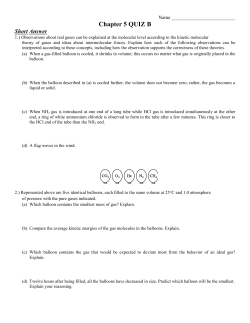
Answers - WordPress.com
Section 1.3: The Carbon Chemistry of Life Section 1.3 Questions, page 28 1. Carbon has four unpaired valence electrons allowing it to form four covalent bonds. Carbon can Section bond with one two other carbons to form straight 1.3:orThe Carbon Chemistry of chains. Life When carbon bonds with three or fourSection other carbons, each secondary carbon 1.3 Questions, page 28 can form a chain resulting in a branched chain. Due to electron repulsion, the bonds form a tetrahedral structure. angles the bonds allow 1. Carbon has four unpaired valence electrons allowingThe it to form between four covalent bonds. Carbon chains carbon bend andcarbons form ring structures. canofbond withtoone or around two other to form straight chains. When carbon bonds with three or 2. Functional areeach specific groupscarbon of atoms molecules are responsible four othergroups carbons, secondary canwithin form aorganic chain resulting in that a branched chain. Due to for the characteristic chemical reactions of those molecules. The same functional group will allow electron repulsion, the bonds form a tetrahedral structure. The angles between the bonds undergo theofsame or similar reaction(s) chains carbon to bendchemical around and form ringregardless structures.of the size of the molecule it is a part of. 2. Functional groups are specific groups of atoms within organic molecules that are responsible 3. Compounds with similar structures often have similar uses. Their is functional dependent group on the will for the characteristic chemical reactions of those molecules. The use same properties of the compounds and the properties are dependent on structures of the compounds. undergo the same or similar chemical reaction(s) regardless of the size of the molecule it is a part 4. Answers may vary. Sample answer: Functional groups help determine if a molecule is polar or of. non-polar. This property determines the types solvents anduses. molecules thatisit dependent is attractedon to.the For 3. Compounds with similar structures oftenofhave similar Their use example, polarofsolvents dissolve polar and ionic compounds and non-polar solvents properties the compounds and the properties are dependent on structures of thedissolve compounds. non-polar compounds. 4. Answers may vary. Sample answer: Functional groups help determine if a molecule is polar or 5. Answers mayThis vary. Sampledetermines answer: Inthe many functional groups, oxygen helps the to. For non-polar. property types of solvents and molecules thatestablish it is attracted polarity of thepolar molecule. In some groups, actscompounds as a reducing by losing electrons example, solvents dissolve polaroxygen and ionic andagent non-polar solvents dissolve fromnon-polar compounds while in other groups, it acts as an oxidizing agent by gaining electrons to form compounds. a bond. 5. Answers may vary. Sample answer: In many functional groups, oxygen helps establish the – 6. (a) –CO2Hof+the H2 O –CO2In +some H3O+groups, oxygen acts as a reducing agent by losing electrons polarity molecule. The from carboxyl group loses ion. it acts as an oxidizing agent by gaining electrons to form compounds whilea hydrogen in other groups, + (b) –NH a bond. 2 + H2O –NH3 + OH – The 6. amino group gains a hydrogen ion. + (a) –CO 2H + H2O –CO2 + H3O – – 2– + (c) –PO H2 + OH group –POloses The4carboxyl hydrogen ion. 4H +aH 2O –PO 4 + H3 O + The (b) phosphate –NH2 +group H2Oloses –NHa3 hydrogen + OH ion. 7. Answer may group vary. Sample answer: Student The amino gains a hydrogen ion. drawings should resemble Figure 6 on page 27 of – – the student textbook. (c) –PO4H2 + OH –PO4H + H2O –PO42– + H3O+ The phosphate group loses a hydrogen ion. 7. Answer may vary. Sample answer: Student drawings should resemble Figure 6 on page 27 of the student textbook. 8. Dehydration synthesis and hydrolysis are both processes that rearrange molecules in organic substances. Dehydration synthesis connects smaller molecules to form larger organic compounds. Water is lost during the process. In hydrolysis, water is added and larger compounds are broken down into smaller and units. 8. Dehydration synthesis hydrolysis are both processes that rearrange molecules in organic 9. This is an example of hydrolysis because the products are smallertothan reactants and water substances. Dehydration synthesis connects smaller molecules formthe larger organic is added. compounds. Water is lost during the process. In hydrolysis, water is added and larger compounds 10. Answers may vary. Sample answer: are broken down into smaller units. Dehydration could be used to form longer and more complex polysaccharides for cell function. Hydrolysis could be to reduce polysaccharides 9. This is an example of hydrolysis because the products areused smaller than the reactants and water into issimple added.more easily utilized sugars. 10. Answers may vary. Sample answer: Dehydration could be used to form longer and more complex polysaccharides for cell function. Hydrolysis could be used to reduce polysaccharides Copyright © 2012more Nelson Education Ltd.sugars. Chapter 1: The Biochemical Basis of Life 1.3-1 into simple easily utilized Copyright © 2012 Nelson Education Ltd. Chapter 1: The Biochemical Basis of Life 1.3-1
© Copyright 2024

















